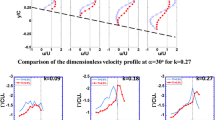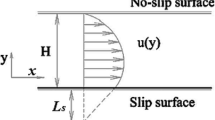Abstract
Time-resolved particle image velocimetry (TR-PIV) and hydrogen bubble visualization are employed to study the effects of Reynolds number on the wake/shear layer interactions over multi-element airfoil (30P30N). The Reynolds number based on the stowed chord length (Rec) ranges from 9.3 × 103 to 3.05 × 104. According to the variation of dominated flow structures, a critical Rec interval from 1.27 × 104 to 1.38 × 104 is found, which is novel for the low-Reynolds-number flow over multi-element airfoil. The slat wakes can be divided into two types by this critical interval. When Rec is smaller than this critical interval, no roll-up occurs to the shear layer of slat cusp. Görtler vortices generated by a virtual curved wall dominate the slat wake. When Rec is larger than this critical interval, roll-ups occur to the shear layer of slat cusp, which is similar to the cases at high Reynolds number (Rec ~ 106). These roll-ups and their evolution result in the co-existence of spanwise vortices and streamwise vortices in the slat wake. Different kinds of slat wake result in different kinds of wake/shear layer interactions above the main element. The flow physics behind these complex interactions, especially the novel flow structures and their evolution, is analyzed in detail to contribute to the fundamental research of wake/shear layer interactions. When Görtler vortices dominate the slat wake, they could trigger streaky structures within the leading-edge separated shear layer of the main element. When spanwise vortices and streamwise vortices co-exist in the slat wake, novel spanwise “double secondary vortices” are triggered above the main element by the spanwise vortices of slat cusp shear layer.
Graphical abstract


This figure is extracted from the figure 29 of Wang et al. (2018)

















Similar content being viewed by others
References
Ashton N, West A, Mendonça F (2016) Flow dynamics past a 30P30N three-element airfoil using improved delayed detached-eddy simulation. AIAA J 29:3657–3667
Balzer W, Fasel HF (2016) Numerical investigation of the role of free-stream turbulence in boundary-layer separation. J Fluid Mech 801:289–321
Boutilier MS, Yarusevych S (2012a) Effects of end plates and blockage on low-reynolds-number flows over airfoils. AIAA J 50:1547–1559
Boutilier MSH, Yarusevych S (2012b) Separated shear layer transition over an airfoil at a low Reynolds number. Phys Fluids 24:084105
Burgmann S, Schröder W (2008) Investigation of the vortex induced unsteadiness of a separation bubble via time-resolved and scanning PIV measurements. Exp Fluids 45:675–691
Carmichael B (1981) Low Reynolds number airfoil survey, vol 1. NASA Technical Report, NASA-CR- 165803
Cenedese A, Del Prete Z, Miozzi M, Querzoli G (2005) A laboratory investigation of the flow in the left ventricle of a human heart with prosthetic tilting-disk valves. Exp Fluids 39:322–335
Champagnat F, Plyer A, Le Besnerais G, Leclaire B, Davoust S, Le Sant Y (2011) Fast and accurate PIV computation using highly parallel iterative correlation maximization. Exp Fluids 50:1169–1182
Choudhari MM, Khorrami MR (2007) Effect of three-dimensional shear-layer structures on slat cove unsteadiness. AIAA J 45:2174–2186
Choudhari M, Lockard DP Assessment of slat noise predictions for 30P30N high-lift configuration from BANC-III workshop. In: 21st AIAA/CEAS aeroacoustics conference (2015) p 2844
Choudhari MM, Yamamoto K (2012) Integrating CFD, CAA, and experiments towards benchmark datasets for airframe noise problems, NASA Conference Paper NF-1676L-14832
Coull JD, Hodson HP (2011) Unsteady boundary-layer transition in low-pressure turbines. J Fluid Mech 681:370–410
Deck S, Laraufie R (2013) Numerical investigation of the flow dynamics past a three-element aerofoil. J Fluid Mech 732:401–444
Deng S-C, Pan C, Wang J-J, Rinoshika A (2017) POD analysis of the instability mode of a low-speed streak in a laminar boundary layer. Acta Mech Sin 33:981–991
Dobrzynski W (2010) Almost 40 years of airframe noise research: what did we achieve? J Aircr 47:353–367
Gaster M (1969) The structure and behaviour of laminar separation bubbles. H.M. Stationery Office, pp 1–31
Hain R, Kähler C, Radespiel R (2009) Dynamics of laminar separation bubbles at low-Reynolds-number aerofoils. J Fluid Mech 630:129–153
Haines A (1994) Scale Effects on Aircraft and Weapon Aerodynamics (Les Effets d’Echelle et l’Aerodynamique des Aeronefs et des Systemes d’Armes). DTIC Document
Hansen H, Thiede P, Moens F, Rudnik R, Quest J (2004) Overview about the European high lift research programme EUROLIFT AIAA Paper 767:2004
He G, Wang J, Pan C (2013) Initial growth of a disturbance in a boundary layer influenced by a circular cylinder wake. J Fluid Mech 718:116–130
He G-S, Pan C, Feng L-H, Gao Q, Wang J-J (2016) Evolution of Lagrangian coherent structures in a cylinder-wake disturbed flat plate boundary layer. J Fluid Mech 792:274–306
Istvan MS, Yarusevych S (2018) Effects of free-stream turbulence intensity on transition in a laminar separation bubble formed over an airfoil. Exp Fluids 59:52
Jenkins LN, Khorrami MR, Choudhari M (2004) Characterization of unsteady flow structures near leading-edge slat: Part I. PIV measurements AIAA paper 2801:2004
Jones L, Sandberg R, Sandham N (2008) Direct numerical simulations of forced and unforced separation bubbles on an airfoil at incidence. J Fluid Mech 602:175–207
Kurelek JW, Lambert AR, Yarusevych S (2016) Coherent structures in the transition process of a laminar separation bubble. AIAA J 54(8):2295–2309
Kyriakides NK, Kastrinakis EG, Nychas SG, Goulas A (1999) Aspects of flow structure during a cylinder wake-induced laminar/turbulent transition. AIAA J 37:1197–1205
Lang M, Rist U, Wagner S (2004) Investigations on controlled transition development in a laminar separation bubble by means of LDA and PIV. Exp Fluids 36:43–52
Lengani D, Simoni D, Ubaldi M, Zunino P (2014) POD analysis of the unsteady behavior of a laminar separation bubble Experimental. Thermal Fluid Sci 58:70–79
Lissaman P (1983) Low-Reynolds-number airfoils. Annu Rev Fluid Mech 15:223–239
Ma L, Feng L, Pan C, Gao Q, Wang J (2015) Fourier mode decomposition of PIV data Science, China. Technol Sci 58:1935–1948
Makiya S, Inasawa A, Asai M (2010) Vortex shedding and noise radiation from a slat trailing edge. AIAA J 48:502–509
Mandal AC, Dey J (2011) An experimental study of boundary layer transition induced by a cylinder wake. J Fluid Mech 684:60–84
Marxen O, Henningson DS (2011) The effect of small-amplitude convective disturbances on the size and bursting of a laminar separation bubble. J Fluid Mech 671:1–33
Marxen O, Lang M, Rist U, Levin O, Henningson DS (2009) Mechanisms for spatial steady three-dimensional disturbance growth in a non-parallel and separating boundary layer. J Fluid Mech 634:165–189
Marxen O, Lang M, Rist U (2013) Vortex formation and vortex breakup in a laminar separation bubble. J Fluid Mech 728:58–90
McAuliffe BR, Yaras MI (2009) Transition mechanisms in separation bubbles under low- and elevated-freestream turbulence. J Turbomach 132:011004–011004
Mueller TJ, DeLaurier JD (2003) Aerodynamics of small vehicles. Annu Rev Fluid Mech 35:89–111
Ovchinnikov V, Piomelli U, Choudhari MM (2006) Numerical simulations of boundary-layer transition induced by a cylinder wake. J Fluid Mech 547:413–441
Pagani CC Jr, Souza DS, Medeiros MA (2016) Slat noise: aeroacoustic beamforming in closed-section wind tunnel with numerical comparison. AIAA J 54:2100–2115
Pan C, Wang JJ, Zhang PF, Feng LH (2008) Coherent structures in bypass transition induced by a cylinder wake. J Fluid Mech 603:367–389
Pan C, Wang H, Wang J (2013) Phase identification of quasi-periodic flow measured by particle image velocimetry with a low sampling rate. Meas Sci Technol 24:055305
Pan C, Xue D, Xu Y, Wang J, Wei R (2015) Evaluating the accuracy performance of Lucas–Kanade algorithm in the circumstance of PIV application Science China. Phys Mech Astron 58:1–16
Paschal K, Jenkins L, Yao C (2000) Unsteady slat-wake characteristics of a high-lift configuration. AIAA paper 139:2000
Pascioni KA, Cattafesta LN (2018) Unsteady characteristics of a slat-cove flow field. Phys Rev Fluids 3:034607
Pascioni KA, Cattafesta LN, Choudhari MM (2014) An Experimental investigation of the 30P30N multi-element high-lift airfoil. 20th AIAA/CEAS Aeroacoustics Conference, Atlanta, Georgia, 16–20 June 2014
Schrader L-U, Brandt L, Mavriplis C, Henningson DS (2010) Receptivity to free-stream vorticity of flow past a flat plate with elliptic leading edge. J Fluid Mech 653:245–271
Simoni D, Ubaldi M, Zunino P, Lengani D, Bertini F (2012) An experimental investigation of the separated-flow transition under high-lift turbine blade pressure gradients flow. Turbul Combust 88:45–62
Simoni D, Lengani D, Ubaldi M, Zunino P, Dellacasagrande M (2017) Inspection of the dynamic properties of laminar separation bubbles: free-stream turbulence intensity effects for different Reynolds numbers. Exp Fluids 58:66
Souza DS, Rodríguez D, Simões LGC, Medeiros MAF (2015) Effect of an excrescence in the slat cove: flow-field, acoustic radiation and coherent structures. Aerosp Sci Technol 44:108–115
Squire L (1989) Interactions between wakes and boundary-layers. Prog Aerosp Sci 26:261–288
Van Dam C (2002) The aerodynamic design of multi-element high-lift systems for transport airplanes. Prog Aerosp Sci 38:101–144
Wang J-S, Feng L-H, Wang J-j, Li T (2018) Görtler vortices in low-Reynolds-number flow over multi-element airfoil. J Fluid Mech 835:898–935
Welch P (1967) The use of fast Fourier transform for the estimation of power spectra: a method based on time averaging over short, modified periodograms. IEEE Trans Audio Electroacoust 15:70–73
Winslow J, Otsuka H, Govindarajan B, Chopra I (2017) Basic Understanding of airfoil characteristics at low Reynolds numbers (10 4–10 5) J Aircr 55:1–12
Ying SX, Spaid FW, McGinley CB, Rumsey CL (1999) Investigation of confluent boundary layers in high-lift flows. J Aircr 36:550–562
Zhu H-Y, Wang C-Y, Wang H-P, Wang J-J (2017) Tomographic PIV investigation on 3D wake structures for flow over a wall-mounted short cylinder. J Fluid Mech 831:743–778
Acknowledgements
This work is supported by the National Natural Science Foundation of China (11761131009, 11721202).
Author information
Authors and Affiliations
Corresponding author
Additional information
Publisher’s Note
Springer Nature remains neutral with regard to jurisdictional claims in published maps and institutional affiliations.
Rights and permissions
About this article
Cite this article
Wang, J., Wang, J. & Kim, K.C. Wake/shear layer interaction for low-Reynolds-number flow over multi-element airfoil. Exp Fluids 60, 16 (2019). https://doi.org/10.1007/s00348-018-2662-5
Received:
Revised:
Accepted:
Published:
DOI: https://doi.org/10.1007/s00348-018-2662-5




